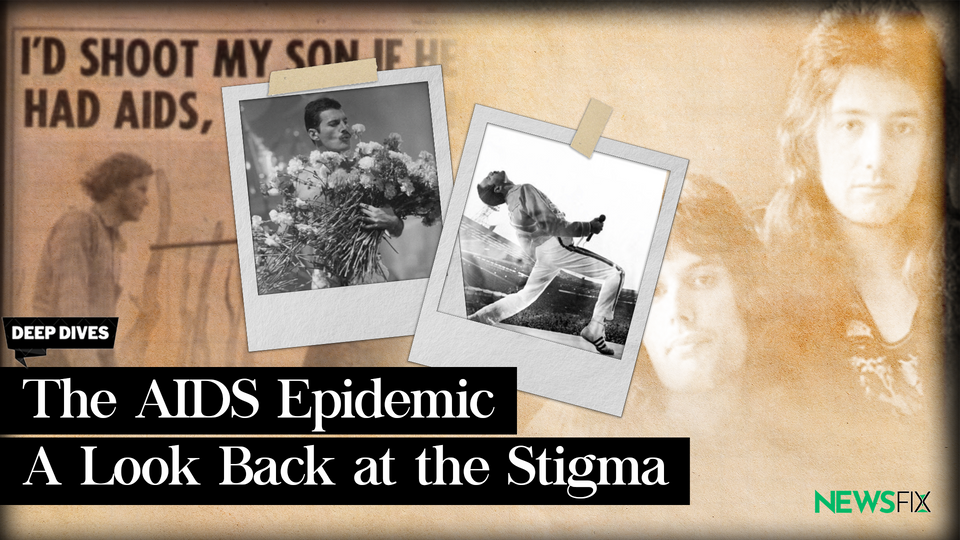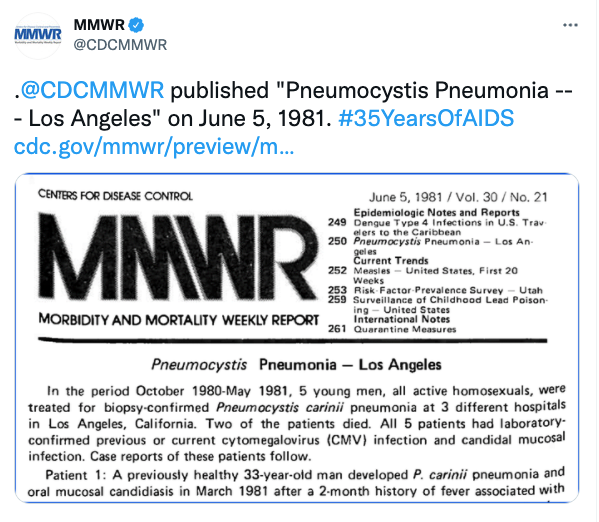⏳ The AIDS Epidemic: A Look Back at the Stigma

Morning all,
This Wednesday marks 30 years since the death of Freddie Mercury, who died a day after revealing he had been diagnosed with AIDS.
While much of his story is well-known, the news this week of a "revolutionary" new treatment for HIV got us thinking about the emergence of the epidemic.
In particular, we wanted to take a look at how it was initially reported, comparing it to changed perceptions today.
Until Monday,
Your Fixers
WHAT ARE HIV AND AIDS?
HIV: It stands for human immunodeficiency virus. It is a virus that damages cells in the immune system, weakening a person's ability to fight everyday infections and disease.
AIDS: It stands for acquired deficiency syndrome. AIDS describes a variety of life-threatening infections and illnesses that can occur when your immune system has been severely damaged by HIV.
HOW IS HIV TRANSMITTED?
HIV can be contracted through certain bodily fluids - including both blood and semen.
Most people who contract the virus do so through anal or vaginal sex, or sharing needles, or other drug injection equipment.
HIV can also be spread in other ways including the transfusion of infected blood, or by being passed from an infected mother to her baby.
THE EMERGENCE OF AIDS
It is believed that HIV first infected humans back in around 1920 in what is today called the Democratic Republic of Congo (DRC), when a strain of the virus crossed over from chimps to humans.
However, it was not until the 1980s that people became widely aware of HIV, and it was recognised as a new health condition - initially in the US.
On June 5, 1981, a report in the US Center for Disease Control's (CDC) weekly public health digest stated that five young, gay men across Los Angeles had been diagnosed with an unusual lung infection known as Pneumocustis carinii pneumonia (PCP) - and two of them had died.

This was the first time a case of AIDS had been reported. A month later, 26 gay men across New York City and California received the same diagnosis.
PORTRAYAL OF AIDS
During the early 1980s, when AIDS was first reported on, it was incorrectly framed as a disease exclusively affecting gay men.
It was often referred to as GRID - which stood for 'gay-related immunodeficiency disease'.
A 1982 New York Times article even described the virus as a "homosexual disorder".

It wasn't until May 1983 - nearly two years after the first reported deaths - that the paper gave the emerging epidemic front-page coverage.
David Dunlap, who worked as a reporter for The New York Times during the 1980s explained; "you knew to avoid it. It was a self-reinforcing edict: don't write about queers."
GOVERNMENT RESPONSE
In the US, it was clear a serious epidemic was unfolding.
In addition to a lack of media attention, the response by the US government was widely viewed as insufficient - something Ronald Reagan's administration is still heavily criticised for today.
The video below features White House Deputy Press Secretary Larry Speakes responding to questions about AIDS. His dismissive responses and thinly-veiled gay jokes speak to the lack of attention afforded to the crisis - as well as the homophobic context of the time.

“With each passing month, death and suffering increased at a frightening rate. Scientists, researchers and health care professionals at every level expressed the need for funding. The response of the Reagan administration was indifference." - SF Gate, 2004
By 1985, AIDS-related deaths in the US had reached 5,636. In September of that year, President Reagan mentioned the word “AIDS” in public for the first time - it had taken him more than three years.
According to Karen Tumulty, of The Atlantic, the delayed response was largely because Reagan believed AIDS should be dealt with as a moral and religious challenge, rather than a health crisis.
Indeed, in 1987 Reagan suggested “maybe the Lord brought down this plague,” because “illicit sex is against the Ten Commandments.”
AIDS IN THE UK
AIDS may have been identified in the US first – but during the 80s it was spreading globally.
On December 12th, 1981, the UK recorded its first AIDS related death – a 49-year-old gay man. By 1985, 58 AIDS-related deaths had been recorded in Britain.
SOCIAL CONTEXT
In the UK, homosexuality between consenting adults may have been partially decriminalised in 1967, but British society was becoming increasingly homophobic during the 1980s.
Beyond the mortal danger of HIV, gay men had to deal with the risk of being ‘outed’ for their sexuality if they had the disease.
“The 1980s were a period of intensified homophobia, sanctioned from the top echelons of society: the government, church, police and tabloids. It was open season on queers.” - human rights campaigner Peter Tatchell
Increasing levels of homophobia during that time are reflected in data published by the British Social Attitudes Survey.
In the UK, LGBTQ+ people were treated as second-class citizens by the tabloid press - with AIDS providing an incentive and a means through which gay and bisexual men could be demonised.
PUBLIC HEALTH RESPONSE
Despite gay men being the most at-risk demographic, public health campaigns failed to address them directly.
According to one expert, this was in fear that this could be seen as endorsing homosexual behaviour.
Below is a clip from a 1986 campaign - and it is easy to understand how interventions like these helped fuel stigma and hysteria.

FREDDIE MERCURY
Freddie Mercury – whose real name was Farrokh Bulsara – was born in Zanzibar, Tanzania, in 1946.
In 1970, Mercury joined a rock band called Smile, which later became Queen. Mercury – alongside bandmates Brian May, Roger Taylor and John Deacon – took the world by storm.
Mercury has been voted the greatest rock legend of all time - but is also a queer icon.
As one columnist wrote, Mercury “redefined mass media through his groundbreaking rejection of conventional norms and a trailblazing flamboyant personality”.
In 1989, Queen released their thirteenth album, The Miracle, but did not tour.
Mercury conducted an interview with BBC Radio 1, where he said that he wanted to break from the "album – tour – album – tour" routine. However, privately, he had been diagnosed as HIV positive in 1987 - and had later developed AIDS.
In 1990, Queen won the BRIT award for outstanding contribution to British music. Mercury’s physical appearance sparked speculation about his health - and it turned out to be his final public appearance.

MERCURY'S DEATH
Mercury disclosed his condition to the public via press release on the 24th of November 1991.
“Following enormous conjecture in the press, I wish to confirm that I have been tested HIV positive and have AIDS… the time has now come for my friends and fans around the world to know the truth, and I hope everyone will join with me, my doctors and all those worldwide in the fight against this terrible disease”.
He died the following day.
HIS LEGACY
Mercury’s statement was impactful - and his death has been described as a “turning point” in the fight against AIDS - catalysing discussion and spotlighting the inefficacy of public health responses in the UK, US and elsewhere.
In 1992, the year after Mercury’s death, the Freddie Mercury Tribute Concert for AIDS Awareness took place and was broadcast in 70 countries. It featured stars such as Elton John and David Bowie, and raised money for AIDS projects around the world.
Building upon this, fellow Queen members Brian May, Roger Taylor and manager Jim Beach founded The Mercury Phoenix Trust - which has given away over $17 million to date, funding more than 1000 HIV and AIDS-related projects around the world.
HIV AND AIDS TODAY
Today, understanding of HIV and stigma surrounding the virus have improved - but for people living with HIV, experiences of discrimination continue to occur.
There is still no cure, but effective drugs exist which enable people with the virus to live long and healthy lives. These drugs are usually in tablet form, and must be taken daily.
Just this week, it was announced an equally effective and “revolutionary” injection will become available in Britain - which needs to be administered once every two months.
Despite a global commitment to stop new HIV infections and ensuring universal access to treatment, there remains some way to go.
Globally there were 37.6 million living with HIV in 2020 - with 1.5 million of those acquiring HIV that same year. These new infections are disproportionately in low and middle-income countries.
The rate of new infections is declining, but only 73% of people with HIV access treatment. That means 10.2 million people (27%) do not - including an estimated six million people (16%) unaware of their HIV status.
While AIDS-related deaths have reduced by 61% since their peak in 2004, last year the disease still killed more than 690,000 people.
We hope you found this to be a helpful and informative introductory piece. Thank you for reading.
